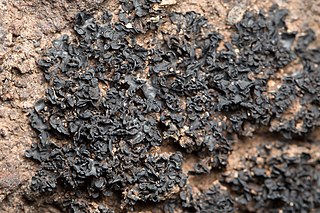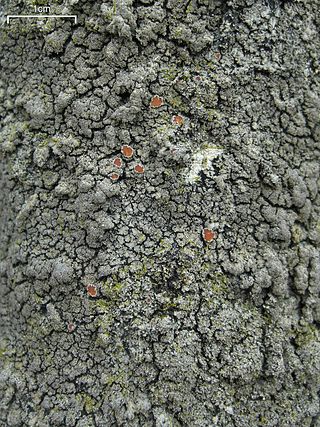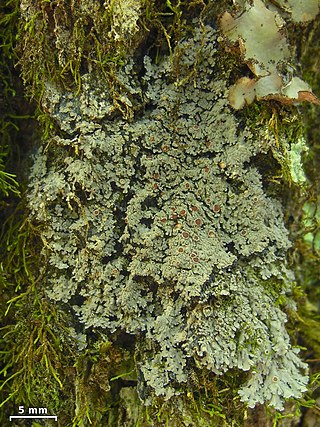
The Cladoniaceae are a family of lichenized fungi in the order Lecanorales. It is one of the largest families of lichen-forming fungi, with about 560 species distributed amongst 17 genera. The reindeer moss and cup lichens (Cladonia) belong to this family. The latter genus, which comprises about 500 species, forms a major part of the diet of large mammals in taiga and tundra ecosystems. Many Cladoniaceae lichens grow on soil, but other can use decaying wood, tree trunks, and, in a few instances, rocks as their substrate. They grow in places with high humidity, and cannot tolerate aridity.

The Pannariaceae are a family of lichens in the order Peltigerales. Species from this family have a widespread distribution, but are especially prevalent in southern temperate regions.

The Lichinaceae are a family of ascomycete fungi. Most species are lichenized with cyanobacteria, and have a distribution largely in temperate regions.

Fissurina is a genus of lichenized fungi in the family Graphidaceae. It has about 160 species, most of which are found in tropical regions.

Protopannaria is a genus of seven species of lichenized fungi in the family Pannariaceae. The genus was originally circumscribed as a subgenus of the genus Pannaria by Hungarian lichenologist Vilmos Kőfaragó-Gyelnik. Per Magnus Jørgensen and Stefan Ekman promoted Protopannaria to full status as a genus in 2000.

Parmeliella is a genus of lichenized fungi in the family Pannariaceae. It occurs mainly in the tropics and sub-tropics, with species found in Africa, Asia, Australasia and South America. A recent (2020) estimate places 41 species in the genus.

Pannaria is a genus of lichen-forming fungi in the family Pannariaceae. The widespread genus contains an estimated 51 species, found primarily in tropical regions.

Fuscopannaria is a genus of lichen-forming fungi in the family Pannariaceae. It has 55 species.

Hypogymnia is a genus of foliose lichens in the family Parmeliaceae. They are commonly known as tube lichens, bone lichens, or pillow lichens. Most species lack rhizines that are otherwise common in members of the Parmeliaceae, and have swollen lobes that are usually hollow. Other common characteristics are relatively small spores and the presence of physodic acid and related lichen products. The lichens usually grow on the bark and wood of coniferous trees.

Lempholemma is a genus of lichen-forming fungi in the family Lichinaceae.
Staurolemma is a genus of lichenized fungi in the family Pannariaceae. The genus was circumscribed by German lichenologist Gustav Wilhelm Körber in 1867, with Staurolemma dalmaticum as the type species.

Alexander Zahlbruckner was an Austrian-Hungarian botanist who specialized in the study of lichens. Johann Babtist Zahlbruckner, an earlier Austrian botanist, was his grandfather.

Lepidocollema is a genus of lichens in the family Pannariaceae. It was circumscribed in 1890 to contain a single Brazilian species that has not been collected since. In 2016, the entire family was revised and updated, resulting in the expansion of Lepidocollema to 24 tropical species.
Per Magnus Jørgensen is a Norwegian botanist and lichenologist, and Professor Emeritus of systematic botany at the University of Bergen. He is known for his work on the lichen families Pannariaceae and Collemataceae. Jørgensen was awarded the Acharius Medal in 2021 for his lifetime contributions to lichenology.
Atrophysma is a fungal genus in the family Pannariaceae. It contains the single species Atrophysma cyanomelanos, a crustose lichen found only in Alaska.
Rockefellera is a fungal genus in the family Pannariaceae. It is a monotypic genus, containing the single species Rockefellera crossophylla. The genus was circumscribed by James Lendemer and Erin Tripp in 2017. The generic name honors the Rockefeller family, "for their century-long support of North American conservation efforts, particularly with respect to national parks."

Lepidocollema marianum is a species of cyanolichen in the family Pannariaceae. It was first scientifically described by Elias Fries in 1825 as Parmelia mariana. Per Magnus Jørgensen transferred it to the genus Lepidocollema in 2014 following a molecular phylogenetics-guided revision of the Pannariaceae.
Degelia neozelandica is a species of foliose lichen in the genus Degelia.

The Collematineae are an suborder of rust fungi in the order of Peltigerales in the class Lecanoromycetes.

Fuscopannaria leucosticta, commonly known as the rimmed shingle lichen, is a species of lichen in the family Pannariaceae. It has a squamulose (scaley) thallus that lacks soredia and isidia, but has abundant apothecia with distinct white rims. Although its main centres of distribution are eastern North America and southeast Asia, where it grows in damp forests, it has been reported from various other high-altitude, humid locations.












